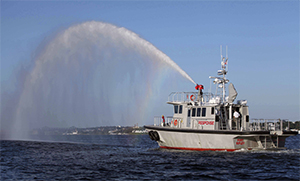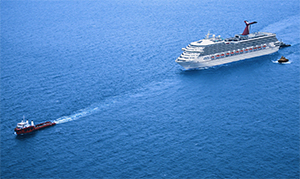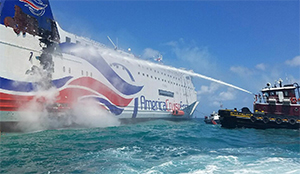The industry debate about vessel owners’ compliance with salvage and firefighting requirements at ports around the country is continuing with the release of a new report criticizing the effectiveness of response plans for Charleston, S.C., and Long Beach-Los Angeles in California.
Subsequently, the U.S. Coast Guard reported that simulation-based checks in 16 ports, including those two harbors, found all of the response plans to be satisfactory.
At issue is whether the Coast Guard has been aggressively enforcing compliance of vessel response plans (VRPs) filed under federal salvage and marine firefighting (SMFF) regulations. The 2009 rules on the availability of 19 types of salvage services stem from the Oil Pollution Act of 1990 (OPA 90) and are designed to prevent spills caused by a fire or an explosion on a vessel.
The new study — conducted by a panel of former Coast Guard officers, two of whom are now attorneys — concluded it was “highly doubtful” that response plans in the Charleston and Long Beach Captain of the Port zones would meet requirements. The review was funded by Rapid Ocean Response Corp. (RORC), which has been critical of Coast Guard enforcement of SMFF requirements and has proposed building a fleet of vessels designed to meet them.
The Atlanta-based company said that Vice Adm. Brian Salerno, Rear Adm. Joel Whitehead, Rear Adm. Roy Nash and attorneys Capt. Laticia Argenti and Capt. David Nichols agreed to do the evaluation only if they had complete independence. The panel interviewed response service providers and looked at verification simulations. The report called the response plans and the Coast Guard verification system “substandard.”
The panel determined that the contracts, which serve as the framework for vessel response plans, are more like letters of intent. They do not require response resources to be available for immediate deployment. “It is clear that Congress and the Coast Guard intended … that capable SMFF response resources will be available when called upon,” the report stated. “Proper legal instruments must be in place to accomplish that goal. Such is currently not the case.”
 |
|
Rapid Ocean Response Corp. has proposed building a fleet of 20 vessels similar to Fort Ripley to meet marine firefighting requirements in ports nationwide. The 64-foot fast response boat from Gladding-Hearn can top 30 knots and pump 3,500 gallons of water per minute. |
|
Courtesy Gladding-Hearn |
The panelists concluded it is highly unlikely that salvage firms could mount a successful response from the two ports for distant near-shore incidents (up to 12 nm from shore) and offshore incidents (12 nm to 38 nm from shore) within the time constraints specified in the regulations. In most cases, the report said, the response would be by a “vessel of opportunity” that would have to return to port if it was not already on site, possibly refuel, load and install the necessary equipment, and then pull together a properly licensed offshore crew.
“The reliance on non-contracted vessels of opportunity is highly problematic as these vessels are under no obligation to respond if called upon, yet they are critical to most SMFF plans,” the report stated. It added that “the Coast Guard … does not properly test whether equipment and personnel listed in vessel response plans will be available and capable for an actual response.”
“The Coast Guard has accepted plans that rely on an approach to compliance that is unreliable and legally insufficient,” said Nicholas Nedeau, CEO of Rapid Ocean Response Corp. “The lack of enforcement by the Coast Guard has given vessel owners a false sense of security. These problems manifested themselves in the recent offshore fires on the Caribbean Fantasy and Bouchard barge No. 255.”
A month after the release of the RORC report in March, Coast Guard Rear Adm. Anthony “Jack” Vogt, assistant commandant for response policy, released an update on the service’s most recent SMFF verification initiative. It is based on 58 scenario-based checks conducted in 16 port zones, with one or more of the 19 SMFF services verified in each zone.
In a blog, Vogt said “vessel owners/operators and their SMFF resource providers have been able to identify resources … within the regulatory planning time frames. Furthermore, SMFF resource providers have provided job histories showing they have a successful record of accomplishment of SMFF services.”
American Salvage Association President Jim Elliott responded that the Coast Guard update “is a testament to our dedication and commitment to continuous improvement of the U.S. and international emergency response capabilities.” He added that “this positive Coast Guard report tarnishes the validity of a recent paper by a special interest (RORC),” and said SMFF regulations have resulted in a significant investment by the U.S. salvage industry.
Nedeau told Professional Mariner that “there are stark contrasts between the process the Coast Guard is conducting and the verification performed by the blue-ribbon panel. The Coast Guard verification process does not address the legal issues the blue-ribbon panel identified as inherent in VRPs that rely upon the ‘vessel of opportunity’ approach to compliance.”
 |
|
Resolve Pioneer tows Carnival Triumph to Mobile, Ala., in February 2013 after an engine room fire disabled the cruise ship 150 miles off the Yucatan Peninsula. American Salvage Association President Jim Elliott has defended the capabilities of his industry and says SMFF regulations have resulted in a significant investment by responders. |
|
Courtesy Resolve Marine Group |
Nedeau added that he could not determine from Vogt’s blog the depth of examination undertaken by the service. “It is evident that only one of the assertions provided by the vessel owner/planholder is actually being verified,” he said. “The only reference to actual verification of information by the Coast Guard is the use of AIS data to determine the location of the identified response vessel.”
“It is difficult to determine how the Coast Guard calculates the timeliness of the response given that the vessel owner/planholder is allowed 10 days to respond,” Nedeau said.
Vogt said in an email that the Coast Guard “continuously looks for ways to improve the vessel response plan review and approval process. The Coast Guard carefully reviewed the Rapid Ocean Response Corp.-commissioned study … (and) also met with the study authors.” He said that the Coast Guard “remains committed to continual improvement and is completing its own independent verification of marine firefighting regulatory compliance within the VRPs to identify and address any regulatory compliance gaps using exercises, improved oversight of contracts and field verification visits in coordination with the planholder as well as their contracted SMFF resource provider(s).”
The Charleston verification was completed in June 2017 and the Long Beach verification in December. Nedeau said the Coast Guard verification in Long Beach did not involve firefighting services, just two salvage services. The verification in Charleston did involve firefighting services — namely, the delivery of a fire team.
“We know from our involvement in the Port of Charleston that there are no local marine firefighting teams, so the verification must have involved the salvage companies assembling and transporting a fire team from out of state,” he said.
Elliott told Professional Mariner that the American Salvage Association supports a Government Accountability Office audit “of the national salvage and marine firefighting posture to provide an independent analysis as a foundation for future policy decisions.”
To meet OPA 90 requirements nationwide, RORC has proposed building a fleet of 20 firefighting response boats similar to the one it already has in operation. The only one built to date, the 64-foot Fort Ripley based in Charleston, can travel at more than 30 knots.

